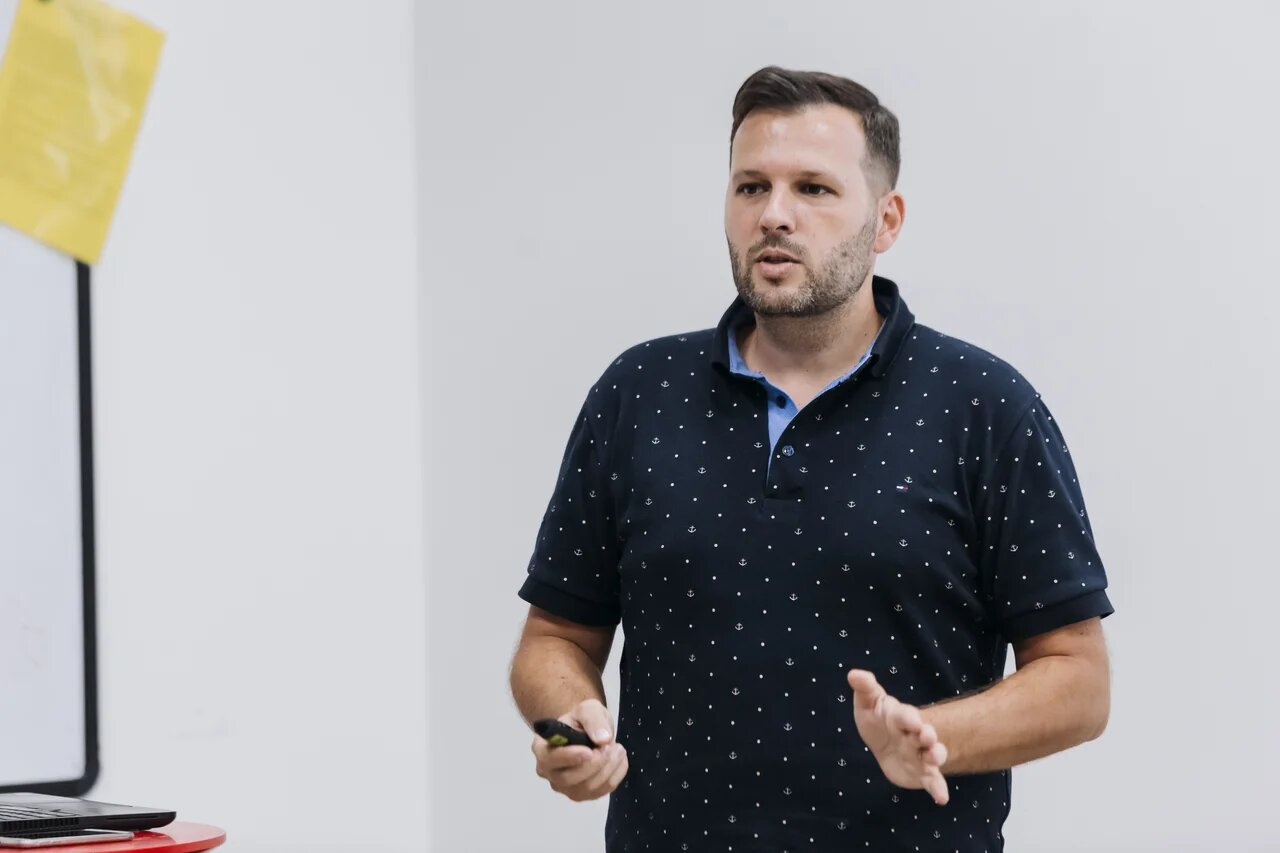Business people want fast and reliable product delivery and a return on their investment. How can you accomplish these goals in a fast-paced environment?
Agile transformation will breathe new life into your organization by creating an environment that embraces creativity and innovation, no matter the size of your business. With the help of our skilled Agile consultants, you will reach large-scale agility.

Pentalog’s Agile consultants will help you figure out your Agile Digital Transformation goals and how to accomplish them. Contact us for more details!
What’s in it for you?
The goal of Agile transformation is to create self-motivated teams that work better together, renew focus on customer satisfaction, reduce processes and plans in favor of action, and increase internal communication and information-sharing.
Agile Leadership Sets the Pace for Growth
The success of your business depends on the quality of your managers. They’re your front-line decisionmakers, set goals, and empower employees. So, it makes good business sense for them to be organized, efficient, and proactive.
Agile leaders focus on three elements:
-
Creating and nurturing a culture in which experimentation and learning are embraced
-
Collaborating with employees at all levels of the organization to find common values and goals for the teams and the company.
-
Creating an organizational structure that reinforces and rewards the other two elements.
Good managers lead by example and teach the organization how to live by Scrum Values. At Pentalog, Scrum Masters are also called “servant leaders”, meaning they primarily focus on the needs of others. This role extends to supporting team members and helping them achieve their goals. It’s a democratic style of leadership.
One of the main responsibilities of a servant leader is removing obstacles that the team might face while fostering an environment where they’re safe from outside interferences.
Even the best teams face challenging times, conflicts, and misunderstandings. The Scrum Master, also known as the servant leader, acts as a conflict mediator by guiding the team towards a healthy debate that results in positive solutions.
Feedback in Agile Teams Improves Workflow
Monitoring feedback improves processes and maintains motivation. Agile teams collect feedback from customers and developers, using their input to improve workflow.
One example of how we monitor feedback at Pentalog is when DevOps engineers set up and run performance tests. This is in addition to providing technical support and guidance to development teams during ongoing sprints. To regularly collect feedback, Agile teams use Sprint Reviews.
When a Product Backlog needs to be updated, the Product Owner and the development team host a joint presentation for stakeholders to examine the product increment. As a result, after the meeting we update and improve the Product Backlog, ensuring delivery of a high-quality product.
Building Trust for Excellence
Trust is how we measure the quality of our relationships. Every team member should feel comfortable enough to express their opinion easily. Sharing ideas and suggestions supports excellent communication.
Pentalog’s teams have the opportunity to share their opinions at four kinds of meetings, which are part of “Agile ceremonies”:
-
Daily Scrum. Each day for 15 minutes, everyone answers three questions: What did I do yesterday? What am I going to do today? Do I have any obstacles?
-
Sprint Planning. Meeting to outline features for the next sprint and update the backlog
-
Sprint Review. At the end of the sprint everyone presents their completed work, including technical functionality or technical information
-
Sprint Retrospective. A 15-30-minute meeting at the end of the sprint where everyone proposes improvements
Agile Strategy for Clear Objectives
Uncertainty and difficulty are the nature of traditional strategic planning for tech and business teams. The Agile organization proposes a different approach: short cycles, and practices that determine potential risks during the project.
For example, Pentalog’s strategy is to prioritize testing according to current goals. There’s a big difference in strategy between Agile teams and traditional ones. Contrary to the traditional organization, Agile teams emphasize flexible prioritization and an iterative approach. Clients are also highly involved in the product development process, which allows us to adopt product changes during development more easily. The end result meets the client’s requirements and market standards. Pentalog’s Agile teams are focused on preventing bugs rather than fixing them later. Likewise, our Product Owners help clients set up a product development strategy adapted to the project’s needs and goals.
Think Ahead, Hire Smarter, Fill in the Gaps
Who is the key player in any product development process? The development team! Without skilled digital and tech professionals, your product won’t reach your customers or turn out the way you planned. To make sure you’re on the right track, recruit people with the right experience and skill who:
-
Work and communicate effectively with other team members and directly with stakeholders
-
Are highly engaged in the development process and ready to suggest ideas for improvement when needed
-
Take responsibility for your tasks
As you can see, it’s easier said than done!
Work with a recognized recruitment specialist who:
-
Will help you define your technical challenges
-
Has a variety of skilled professionals ready to join your team
-
Can assess your candidate’s soft and hard skills
Meanwhile, consider gender equality in your team! What could you do? Implement a thoughtful recruitment process and organize educational events to help young women make the STEM field their career choice. At Pentalog, women make up more than 40% of our software project teams. Recently, our PentaGuys and PentaGirls participated in Django Girls in Chisinau (Moldova) to help women take their first steps in IT.
Advantages of Agile Transformation:
-
Reduces Cost – clients get what they want with near real-time feedback
-
Reduces Risk – employing transparency and communication
-
Allows Flexibility and Innovation – welcome changing requirements
-
Reduces Waste – spotted sooner, easier to eliminate, no piles of useless documentation
-
Get Better ROI – short delivery cycle means quick time to market
-
Increases Productivity – focus on high value, high priority features and the most efficient way to produce them
-
Improves Morale – more individual autonomy; fosters trust, self-confidence, and fewer decision flows
-
Improved Quality – QA is finished faster and more often, ensuring ongoing improvement at every stage
-
Happier Customers – misunderstandings are quickly clarified, problems and issues identified and tackled earlier
For those who want to achieve these results, agile is like a “magic pill”. It provides many advantages if you invest something in return. Otherwise, it may not work as expected. For an Agile process to form, you need a commitment from every team member, a good understanding of the methodologies at hand, and a continuous desire to learn from your mistakes.
Agility User Manual
Think outside the box. Even better: there is no box.
Have you ever heard of the term VUCA? Regardless of your answer, it has already affected you! Many entrepreneurs describe today’s climate in four words: Volatility, Uncertainty, Complexity, and Ambiguity. Considering that 100 million startups are born each year worldwide, the key to success is, always be ready to accept change and adapt.
At the JAX London Conference 2019, I gave a presentation that, hopefully, helped the audience achieve Agile transformation. So, let me share with you the steps to becoming Agile:
Step 1. The team should start with iteration. Agile PDCA Cycle will help you:
-
Plan – What are the team’s strategic goals? What are the risks? How are you going to achieve these goals?
-
Do – What key assumptions does your team need to test early on to validate your strategy?
-
Check – Did early experiments turn out as you expected, or not? What went wrong? Can you prevent it in the future?
-
Adapt – If something new was discovered, how does this change the strategy?
-
Go back to the first step over and over again as needed
Step 2. Priorities of the team should be kept under control.
In this case, prioritization techniques like MoSCoW are at your service:
-
M – Must have – Product needs that are mandatory and can’t be postponed
-
S – Should have – Actions that aren’t critical now, but are important
-
C – Could have – Initiatives not related to core functions
-
W – Will not have – Tasks that will not be implemented in this release, but may be prioritized in the future
Step 3. Keep the team happy and watch as they achieve milestones one by one.
“When everyone is trying to manipulate everyone else, should we be surprised that problems never go away, and new ones keep popping up? When people don’t focus on improving themselves, is it any wonder they’re always complaining about each other?” Jurgen Appelo raised these questions in his book “Managing Happiness”. His point: If you want to keep your team happy, promote two crucial principles:
-
Transparent communication where all voices are heard
-
Solutions-oriented mindset instead of complaints

If you want your team to be efficient, follow these rules: only do what matters, value time, and respect the budget!
Step 4. Repeat all the previous steps.
-
Plan your sprints and complete your retrospectives;
-
Adapt to the team’s needs;
-
Ensure the whole team plays by the same rules;
-
Handle tasks using a holistic approach
Apply Agile with No Limits
Agile extends beyond IT, becoming a universal improvement tool in a variety of industries.
Enterprise projects may benefit from Agile practices like:
-
Sprints
-
Backlogs
-
Iterations
-
Continuous integration
-
Cross-functional teams
-
Scrum Meetings etc.
Where there is room for improvement, Agile claims its place. With an Agile approach, keep in mind that your goal is not to walk someone else’s path; the main objective is to be better every step of the way to your final goal. It will help you be more prepared, less stressed, and happier along the way.
We match words with deeds! Read Pentalog’s client testimonials for yourself!
To achieve Agile digital transformation, contact our Agile consultants!


 (11 votes, average: 4.64 out of 5)
(11 votes, average: 4.64 out of 5)






